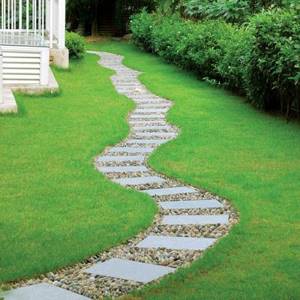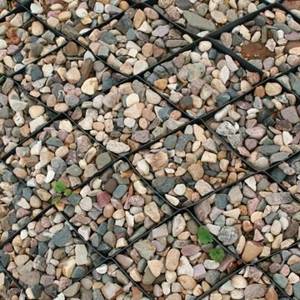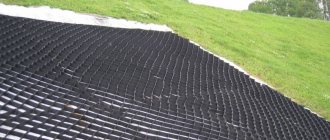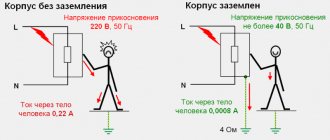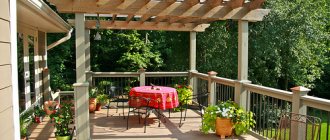Happy owners of summer cottages and country houses often puzzle over how to lay high-quality garden paths at minimal cost, so that after six months they do not have to spend money on their repair and restoration.
An excellent solution to this problem is to use a geogrid when forming the base of the tracks.
Geogrid is three-dimensional plastic cells of various shapes. Most often they have a square, diamond or honeycomb shape.
|
|
Forming a track using this material is very simple. The honeycomb is simply filled with a mixture of gravel and crushed stone, and a strong, reliable base is formed.
is a wholesale supplier of various excellent quality geogrids. We operate in Moscow and remote regions and today offer a huge range of geosynthetic materials at the best prices.
The use of geogrids for paths in the country
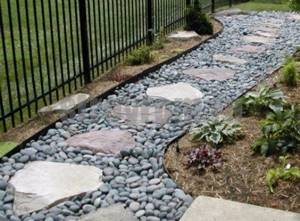
Often, summer residents and rural residents are faced with the problem of erosion of garden paths as a result of exposure to water and moisture, as well as destruction of its integrity under the influence of gravity. That is why the paths have to be replenished or rebuilt at repeated intervals. Heavy farm equipment and large pets also contribute to the rapid deterioration of garden paths.
An excellent solution to permanently eliminate this problem is the use of volumetric geogrids. They cope with the task perfectly and significantly increase the bearing capacity of the base. The geogrid eliminates the possibility of movement of soil layers and thereby extends the life of garden paths, while eliminating the need for annual repairs and costs.
Another application in the country: we strengthen the slopes
It is likely that your dacha has slopes and other uneven terrain that should be strengthened for safety.
The geogrid will be useful in this case too, and it can prevent even very steep slopes from sliding down. To fill the cells of such a grid, sand, soil, pebbles, crushed stone and other materials are used. The steeper the terrain unevenness, the greater the width of the side elements of the lattice should be. This material is the most popular and convenient to use if you need to prevent landslides. Thanks to the reliability, durability, and good stretch of the plastic grid, you will be able to carry out work even on surfaces with difficult terrain.
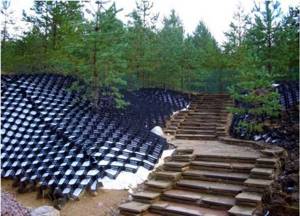
How to lay a geogrid with your own hands? To install a grating on a slope to perform the strengthening function, perform the following procedures according to the installation technology:
- try to level the slope that needs strengthening;
- Taking into account the steepness of the slope, mark its boundaries;
- place geotextile material on the slope;
- install strong anchors (from 0.6 to 0.9 meters), focusing on the marks;
- now pull the geotechnical grid itself onto the built-in anchors, starting work from the upper level of the slope;
- when stretching, fix the grid using an G-shaped anchor for fastening and keeping a step of approximately one to two meters;
- When the lattice is secured, start filling the cells, also starting from the top. A slide at least three centimeters high should be visible above the cells.
Tip: you can fill the cells with vegetation with an active root system, which, as it grows, will anchor it even stronger.
If the work is done correctly, this building material will provide reliable soil reinforcement for a long time. In this case, the costs of carrying out the described work will be minimal.
Due to its properties and practical characteristics, geogrids are increasingly used in construction work in summer cottages. Moreover, with proper design, it will also become a stylish addition, emphasizing the beauty of the natural landscape, and will provide you with a comfortable time in the fresh air.
Installation of geogrid for paths in the country
Installation of garden covering using geogrid is quite simple. You must first clear the area of excess debris and dig a trench around the entire perimeter of the garden path to a depth of about 30 cm.
Geotextile fabric is laid at the bottom of the trench and a grate is installed. The cells are half filled with gravel, the rest with fine sand.
Next, a shock-absorbing sand cushion about 5 cm thick is formed. It is moistened layer by layer with water and thoroughly compacted. A layer of non-woven needle-punched material is laid on top and the finishing process begins. For it, most often any available material is used or a monolithic concrete structure is formed.
Geogrid - what is it?
Geogrid is a honeycomb-shaped building material made from geosynthetic polymer. The size of the honeycomb cells varies depending on the purpose of the grid. The height of the honeycomb, as well as the length or width, may vary. High-strength welds guarantee reliable fastening of the sections, which are arranged in a checkerboard pattern.
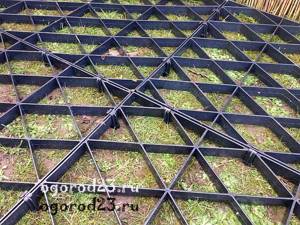
Volumetric geogrid
This material, when stretched, creates a stable reinforcing frame for subsequent construction work, during which the cells are filled with crushed stone, sand, soil or other fillers.
For various applications, two types of cellular structures are used - volumetric and flat . A volumetric geogrid (or volumetric geogrids) is attached using metal or solid plastic anchors.
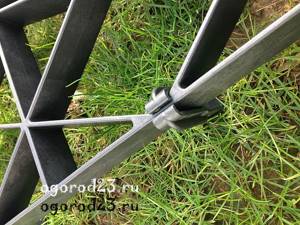
Mounting element for fixing the geogrid in the soil
The height of the honeycombs of this material varies from 5 to 30 cm, and has similar values diagonally. The volumetric geogrid does not lose its performance qualities for 50 years. The design is resistant to environmental aggression, its installation does not involve any special difficulties, and it can withstand temperatures from -60 to +60 °C.
A feature of flat-type geotechnical grating is the mechanical fixation of the material with which the honeycombs are filled. This can be crushed stone, gravel, sand or soil. Flat geogrid is characterized by high strength in all directions and can withstand significant static or dynamic loads.
Biaxial geogrid, application:
- for reconstruction, fixing the base of various types of road surfaces (creates a separating and reinforcing layer);
- strengthening the banks of artificial reservoirs;
- in different areas of landscape design;
- in the construction of parking lots or parking lots for cars of any kind.
Additional Geogrid Features
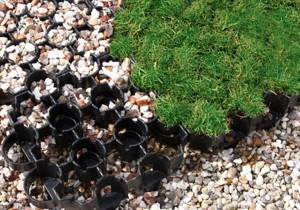
When forming a blind area, you can also use a geogrid. It provides high load-bearing capacity of the blind area and prevents its destruction during operation. A blind area made using geosynthetic materials can perfectly resist soil heaving and maintains the integrity of not only the area adjacent to the house, but also the foundation.
General advantages of using geogrid
The choice in favor of a geogrid when landscaping areas is justified by such positive characteristics as:
- resistance to corrosion development;
- relatively low cost;
- excellent load-bearing characteristics to withstand high loads;
- the ability to withstand the negative effects of salts, acids, alkalis;
- no risk of rotting, mold and fungus spreading;
- unattractive to rodents and insects.
The use of geogrids for summer cottages
Volumetric gratings made from synthetic polymers are very often used in landscape design. Among their positive features are:
- Strength, durability, immunity to loads and other influences;
- The ability to strengthen layers of bulk substances by binding them together;
- Possibility of repeatedly increasing the load-bearing capacity of the foundations of objects.
Very often, geogrids are purchased to combat landslides, create artificial unevenness, as well as fill gaps and much more. However, they are necessary not only for large-scale work, but also for use on a personal plot.
What kind of geogrid can it be?
Most often on sale you can find gratings made of synthetic materials - for example, polyamide, polyester or polyethylene. They are characterized by increased elasticity, as well as excellent durability due to resistance to all types of external influences. An alternative is materials based on fiberglass. Such gratings have much greater strength, but are characterized by increased mass and very low elasticity. In addition, geogrids may differ in shape. Let's look at their main types.
Flat gratings
Flat geogrids are often called geogrids. They are very often used in road construction. Certain types of gratings can be laid directly into asphalt concrete pavement, which allows them to be used when repairing transport routes. In addition, with the help of flat meshes, the shock-absorbing cushion or slopes of the railway track are stabilized. In landscape design, flat geogrids are used much less frequently. With their help, the surface of slopes of slight steepness can be strengthened. Experts recommend using them at an inclination of no more than 30 degrees.
Volume lattice
When constructing roads, main utilities or various objects, volumetric geogrids are used. They are made from synthetic materials of high elasticity, due to which such materials do not bend or crack during transportation, and can also be laid under any climatic conditions. In fact, the walls of the volumetric gratings are a non-woven geo-fabric, which allows them to achieve high strength. Due to its ability to be filled with soil, the volumetric grid is often used in landscape design, agriculture and in the creation of soil structures.
Perforated grille
Grids made from polymer materials by extrusion are often equipped with perforations. It helps to achieve a high level of adhesion to surrounding surfaces, as well as ensure effective drainage of the structure. This type of geogrid is usually used to strengthen various structures in landscape design and industrial construction.
Buying geogrids in Moscow and the region
To buy a geogrid at an adequate price in Moscow, it is best to use the services of its manufacturer, because intermediaries and dealers significantly increase the cost of products. Among the top manufacturers who, in addition to production, also sell manufactured materials, it is worth noting the company Armplast. Proven over the years, this brand is famous for the quality of geosynthetic materials and reasonable pricing policy. By contacting the company at the phone numbers listed on the website, you will receive comprehensive information and can immediately place an order, determining the scope of delivery and the final price.
You can find out the cost, check availability in your region and calculate delivery by calling 8
or by leaving a request on the website. Place an order on the website
Features of geogrid installation
Of course, the mesh structure should be installed at the initial stage of the construction process - after leveling the site (excavation work). To install a geogrid, a necessary element is geotextile, which is responsible for redistributing the load that falls on the coating. This material is laid under the geogrid. The mesh structure must be secured with so-called metal anchors.
It is worth noting the fact that the cavities of the structure are half filled with local soils, sometimes this figure reaches up to 80%. The volume that remains is filled with medium-sized crushed stone. The resulting base must be covered with non-woven geotextile, which is responsible for partial load absorption and drainage of the road surface.
Strengthening the soil using geogrid
When creating paths on a summer cottage, near a private house or in a small park, a problem arises related to their reliability. When heavy rainfall occurs, such structures are often washed away, which leads to their destruction within 2–5 years. In addition, the reason for the loss of appearance of paths is frequent walking on them and the use of various agricultural equipment, such as wheelbarrows. The transport of special equipment - walk-behind tractors, cultivators, etc. can also damage the paths.
The only way to solve the problem is to increase the bearing capacity of the soil base. For this purpose, volumetric geogrids are used. By preventing the path from pushing deep into the soil, as well as eliminating the movement of the soil layers located underneath it, it significantly increases the service life of the structure and also reduces the time spent on its repair.
Polymer geogrid
Flat, high-strength product with rigid connecting nodes. Manufactured by extrusion, it has high longitudinal and transverse strength.
It is used to strengthen the surface on railway and construction sites, as well as for protection against rockfalls.
Advantages:
- Separates materials of different fractions and prevents mixing of layers.
- Strengthens the load-bearing layer of the road base.
- Increases the service life of the coating in heavy traffic areas.
- Installation is easy.
